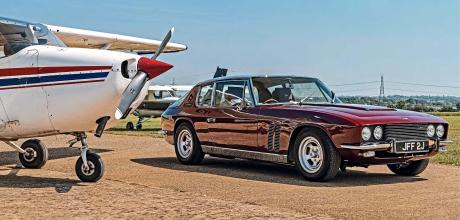1971 Jensen FF MkII
Industrialist’s plaything, footballer’s wife’s daily driver and subject of a community-wide quest for survival, this Jensen FF has seen it all.
Words NATHAN CHADWICK
Photography ALEX TAPLEY
Excess & More
Driving, and recalling the life and times of, a football star’s Jensen FF
There’s an element of the rock opera about the Jensen FF – as a concept album with number plates, it fits the bill. Most concept albums experiment in some form or another, and the FF – a car owned by musicians such as Ginger Baker, Mitch Mitchell and John Bonham – pushed the boundaries for 1966. The model is famed for being the first four-wheel-drive production car, but it was also the first road car with anti-lock brakes. Of course, the best rock albums need a great sound, and that comes from the 6.3-litre Chrysler V8 beneath the FF’s long bonnet.

This particular example of the FF probably deserves a rock opera all of its own, however – high-flying executive’s chariot turned daily family car; two major crashes and several poor restoration attempts; it’s all there. It’s fresh from an 17-year restoration and a spectacular debut at the London Concours, and the living, breathing representation of one of the current owner’s prized childhood book cover cars. Now, let’s reflect on the Good Times (and) Bad Times…
‘Basically, I was very keen to have the car, so I put what I thought was a sensible bid for a very bent Jensen,’ recalls current owner Kieron Maughan. ‘I came back downstairs the next morning, having won it for £4874 – I couldn’t work out how. Then I remembered I’d had a few glasses of wine; turns out I’d accidentally set the maximum bid at £48,000, rather than £4800. So, either way, I was ending up with a very bent Jensen.’
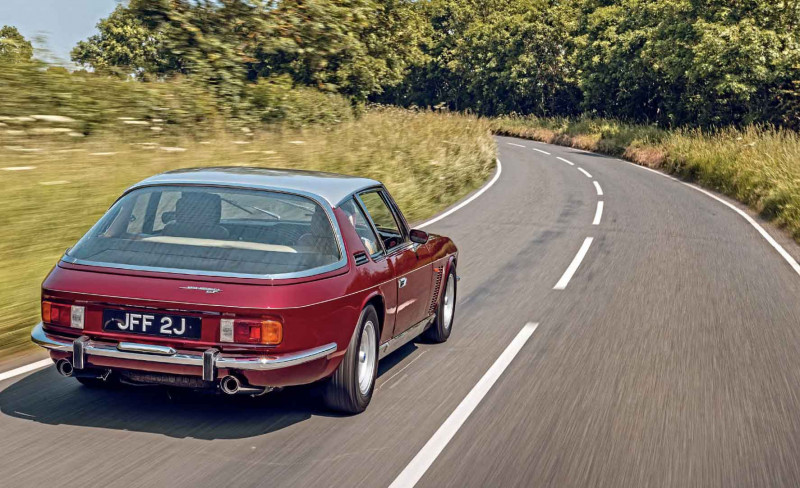
Slicing through the fast A-road I’m on, this FF certainly doesn’t feel bent in any way. If anything, it seems to have a single-minded straight-line goal, with little regard for fuel consumption and, well, much else. There’s something delightfully resolute about the FF, as befits a car on the sharp edge of innovation in 1966 – bragging rights for the uncompromising man or woman about town.
Suitably, the Jensen’s cockpit is all about the driver. A wall of instruments recessed deep into dark plastic and leather, a nononsense ball-topped pole of a gear selector and almost Tonkatoy- style switches – it’s all chunky and unapologetically matter-of- fact. What the FF’s cabin may lack in refined elegance, it makes up for with simplicity and ease of use.
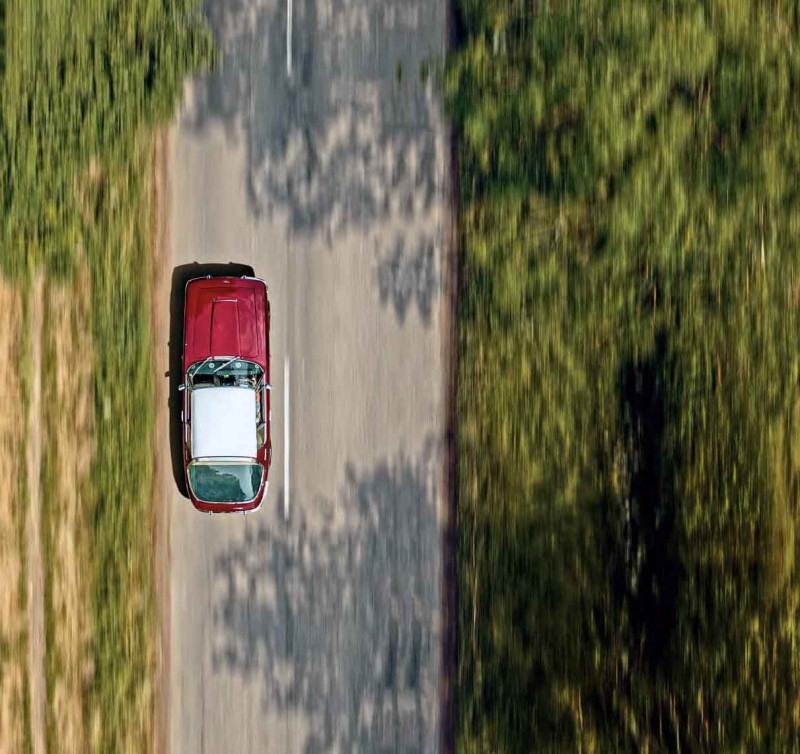
There’s plenty of space – well, for the driver. The passenger has distinctly less room, which is also the reason no lefthand- drive FFs were built. The central transfer case and two propeller shafts chomp into the area where your leg would be if lefthand drivers were afforded the same cabin space, while rhd passengers had better get used to the ‘knees together’ position.
The brake servo and steering gear are both on the right, and there’s no room for them on the left, despite a transmission tunnel so wide you could probably park a Mini on it. This obviously diminished the market for the FF, which was a critical problem – by the early Seventies Jensen’s main markets were overseas, and the car couldn’t be sold in the lucrative USA market. In the end, just 320 were built over five years.
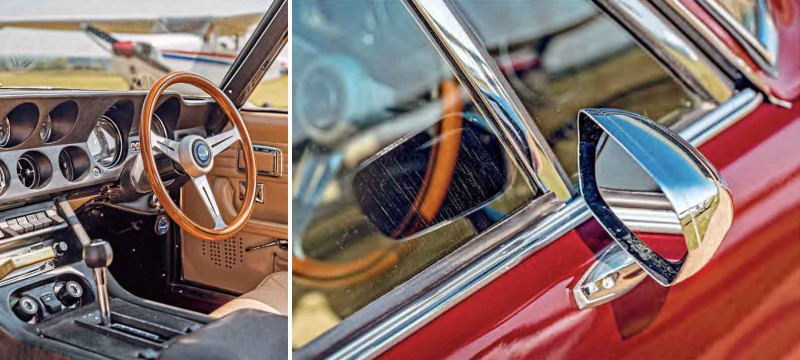
Gripping the aftermarket Nardi wooden steering wheel, it’s time for me to see what 6.3 litres of Detroit V8 and four-wheel-drive can do on a blisteringly hot day; not just because 325bhp promises pacey ground covering, but my thigh is also being toasted by the transmission tunnel – I ponder my potential fate as a ball of fire to rival any glam rocker’s stage pyrotechnics.
The FF is no ball of fire itself, however. I squeeze the throttle, expecting muscle car heave – but while there’s a wall of noise playing a familiar Chrysler V8 bass note, the tempo doesn’t quicken. I plant the throttle harder and the TorqueFlite AZ727 three-speeder eventually girds its ratios… but still the punch doesn’t come. Perhaps the FF’s reputation as a rock star’s car precedes it – is this the ultimate dance-rock song, three minutes of adorable excess, with a lack of depth behind it?
Given the FF’s weight, it’s more like an 40-minute prog rock epic; the FF tips the scales at 1800kg, some 200kg more than an Interceptor. You really can feel the weight of the four-wheel-drive system blunting performance.

I am, however, missing the point, which is beautifully illustrated as the road starts to curl up. Big GTs tend to become painfully awkward in such situations, crying foul away from their natural sweeping A-road and motorway playgrounds. This sulk usually manifests via heavy steering, obstructive gearchanges and a lot of torque smearing itself across the rear axle, vainly looking for purchase on often-adverse cambers. Not here though – instead, the FF feels remarkably modern. First, the Dunlop Maxaret anti-lock braking system – previously the preserve of trucks, aeroplanes and racing cars – calms the horses without complaint, and as I get on the throttle earlier and earlier, I feel the four-wheel-drive system dragging me out of the apex. It’s not thrilling in a traditional sense; it’s more satisfying than scintillating, a genuine every-day exotic — novel for 1966, when the FF was launched.
‘It swallowed up the kids on the school run, while the large boot proved invaluable for shopping’
The first owner of this example, James Fatorrini, certainly piled on the miles in the first year, though he patently wasn’t satisfied. Based in Bradford, he was the vice chairman of Empire Stores, and racked up 35,000 miles – though not overly happily, as terse correspondence with Jensen reveals. There were problems with the gearbox, steering rack and ignition switch and lock, some of which Kieron attributes to Fatorrini using the FF as a tow car. In a letter to Jensen Fatorrini wrote, ‘The Jensen agent would not touch the car but got one of your technical experts up from the factory, and the general opinion was that the car was past its best and I should get a new one. I might get a new car, but I will certainly not get a Jensen again. To think a car that has cost £9000 and has only done 35,000 miles is past its best is ludicrous.’
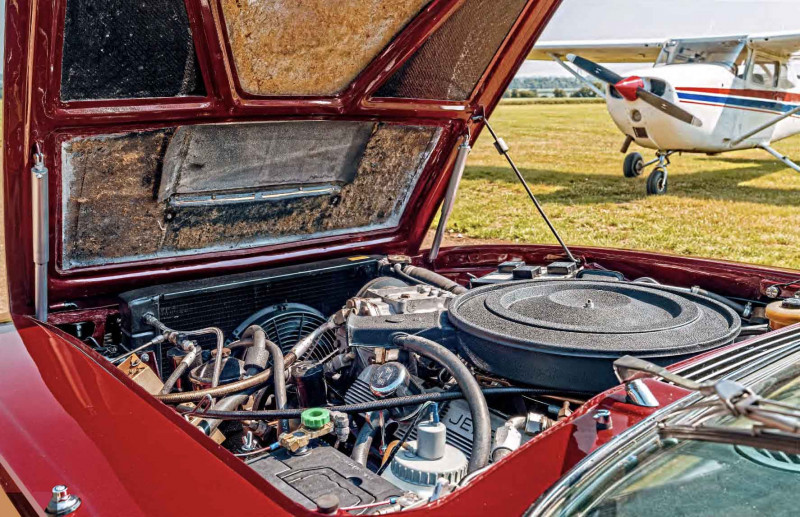
Fattorini sold the car in late 1972/early 1973; the Jensen ended up in Surrey and, fairly soon after, a body shop to replace or repair most of the forward body panels after a hefty prang, at a cost of £710. By the time the car found its next owner in 1977, its Pastel Grey paint had gone in favour of vivid yellow with a black vinyl roof, and it rode on Wolfrace Slotmag wheels. This combination proved irresistible to Lance Robson, a professional footballer for Darlington FC and the operator of a dental practice. He was looking for a replacement for his wife Barbara’s E-type and the Jensen took his eye particularly because it had the special number plate, SBR 5, which he interpreted as ‘Sexy Barbara Robson’. Over the next few years, the FF fitted into everyday life; the generous seating arrangements swallowed up kids and their friends on the school run, while the large boot proved invaluable for shopping. Eventually, the tide of electrical and mechanical problems that came with such everyday use became too much, and the car was laid up for ten years until Lance Robson Junior saw a Sunday Times article extolling the virtues of the FF. He suggested that the car should be restored; unfortunately Lance Senior passed away in 1987 before the work could begin.
Six years later it was treated to a bare-metal respray and several replacement body panels, but the first restorer went into administration. The next firm resprayed the car again in crimson maple metallic, and got the car running – but only just. With more than £50,000 spent on a car that didn’t run correctly, the family gave in and sold the Jensen in 2002, to County Durham-based dealer Martyn Douglas.
He found a buyer, but before it could be delivered the throttle stuck wide open and the FF hit a tree, causing huge damage to the driver’s side front quarter. The sale fell through, and the car eventually ended up with an amateur restorer who didn’t get very far with it. Fast forward to 2006, and Kieron’s keyboard fumble – but just what had he bought?
‘It was largely complete,’ he says. ‘Bizarrely, the owner had taken some parts out of the car, such as the interior, but had done nothing about the damage to the front.’
That damage necessitated a new front wing, inner wing, chassis leg and front panels; work was also done to rectify the poor restoration efforts inflicted upon it over the years. The source of the poor running turned out to be water getting into the fuel tank, but Kieron also wanted to put his own twist on the car. ‘This car shouldn’t exist because it was going to be sold for spares, so I’ve decided to do what I wanted with it,’ he says.
So began an 17-year restoration that the Jensen Owners Club and the wider community got behind in a worldwide hunt for parts. ‘The main guy from the club point of view was Dave Barnett, who did a lot of the work and early assembly, and helped right through ’till the end while Paul Brookbanks project managed the car in the early days, and Terry Hewett and Paul Broom from Classic Bodyworx in Peterborough completed the special paint,’ Kieron says. Final assembly was completed by Kieron’s friend Tim Glover, while the replacement panels were made by Ron Everett Clay. ‘Ron is a genius,’ says Kieron. ‘He has all the factory drawings; even without the car in front of him, when the pieces turned up they fitted perfectly.’
The finishing touch was the distinctive look, and for Kieron, the inspiration behind this FF’s eye-popping colour combination is personal. ‘I was given a copy of a booklet called The History of the Motor Car aged six – on the cover was a Candy Apple red Jensen with a silver roof,’ he says. ‘I loved that car, and I’d kept referring to the booklet over the years – when I finally chose the colour, I’d inadvertently chosen the same colour as the booklet.’ Oh, and that pinstripe – that’s hand-painted by Ben Purdy – the one man brave enough to take the job on.
Kieron is a huge fan of big rock from the era – the freshly rebuilt eight-track player has Led Zeppelin in it – and the car fully leans into the customising era that goes along with it. ‘I was quite chuffed that it had spent much of its life on Slotmags,’ he says, before pointing to the Jensen-badged centre caps he had custom-made to adorn them. ‘The rest of the car is pretty much standard, other than Mopar electronic ignition and a custom stainless steel exhaust and headers.’
The Jensen drew plenty of attention at the 2023 London Concours, though there were some last-minute dramas with the front hubs, again resolved by Dave Barnett and Tim, and Vintage Tyres came through with the right rubber just in time. The Robson family has yet to be reunited with the FF, but that’ll happen soon. ‘Barbara’s sons were quite emotional when I sent them the pictures of the restored car,’ says Kieron proudly. ‘Guy Robson vividly remembers being aged six, screaming at his dad to go as fast as he could down the M1.’
I hand the keys back to Kieron. Emotions are an interesting part of this car’s make up. No, it won’t stir the soul like an Interceptor, but on the other hand, it rewards a long-term relationship. Much like those epic rock records that reveal ever more secrets with repeated plays, the FF deserves another spin. Trust a Brit to complain about the weather, but here goes: the blinding sun, searing temperatures and dry ground do not paint the FF in the best light. For that, you need to picture lashing rain and epic early-era motorway drives across the country, charging through the night to the next gig.
It’s a romantic notion, certainly, but it aptly goes to the heart of why this machine is so special; you don’t need special skills to drive an FF quickly.
This particular example’s many years as a daily driver point to that; the only fly in the ointment is a taste for premium unleaded that will have your local branch of Just Stop Oil bulkbuying superglue every time you fire it up. But what would rock music be without a dollop of excess? Either way, the FF deserves a Whole Lotta Love…
TECHNICAL DATA 1971 Jensen FF MkII
- Engine 6286cc V8, ohv, Carter AVS carburettor
- Transmission Three-speed automatic, all-wheel drive
- Max Power 325bhp @ 4600rpm
- Max Torque 425lb ft @ 2800rpm
- Steering Power-assisted rack and pinion
- Suspension Front: independent, wishbones, coil springs, non-adjustable dampers. Rear: live axle, semi-elliptic leaf springs, non-adjustable dampers
- Brakes Servo-assisted discs front and rear, Maxaret anti-lock brakes
- Performance Top speed: 140mph
- Acceleration 0-60mph: 7.4sec
- Weight 1830kg (4034lb)
- Fuel consumption 12mpg
- Cost new £9000 in 1971
- Classic Cars Price Guide £80k-£150k
‘Picture lashing rain and epic motorway drives across the country. You don’t need special skills to drive an FF quickly’
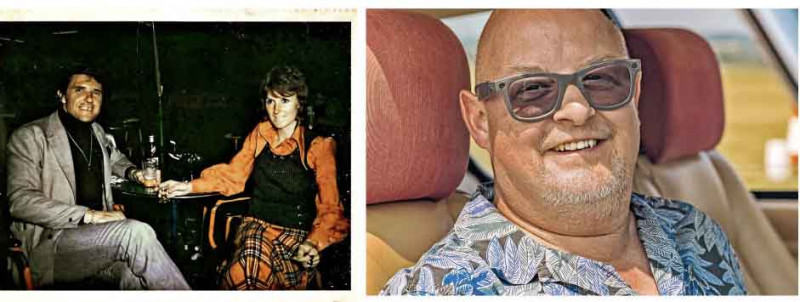
Lance Robson with wife Barbara.
FFs are easy to distinguish from Interceptors – note extra length and twin wing grilles.
Two-tone scheme not original, but highly nostalgic for current owner.
TorqueFlite selfshifter keeps ratio twirling smooth.
FF offers many opportunities for reflection – usually after a resto bill.
Aircraft-derived ABS gave the FF jetset credibility.
Handling is impressive, if not electrifying. Chrysler V8 displaces a mighty 6.3 litres. Unmistakably American, despite badge.
‘I was keen to have it, so I put what I thought was a sensible bid for a very bent Jensen’
OWNING A JENSEN FF
‘I love that you can just get in it and go,’ says Kieron Maughan. ‘It’s not like an Italian multi-cam V12 that takes a while to warm up.’ Kieron runs the Rockstars Cars project (rockstarscars.co.uk) and owns the Led Zeppelin Schuler Range Rover and John Bonham’s Jensen Interceptor; the latter is a project but he also owns another, fully-working Interceptor, alongside several other interesting cars. ‘The Interceptor is nimbler, lighter and faster than the FF, but this car will get you home in the rain or snow,’ he says.
Since the car has only just returned from its restoration, Kieron is still de-snagging it, but hopes to use it regularly. ‘While not really something I’d use as a daily car, I’ll be looking to drive it two or three times per week – I definitely won’t sell it after the journey it’s been through to get to this stage,’ he says.


